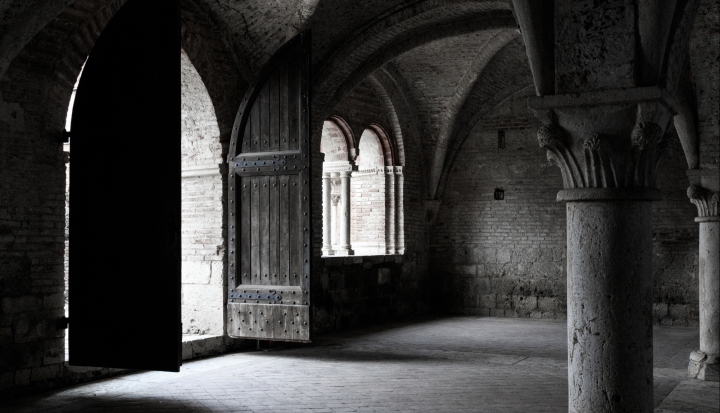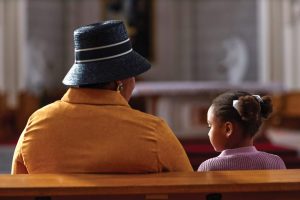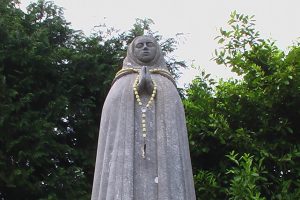“Listen! I am standing at the door knocking; if you hear my voice and open the door, I will come in to you and eat with you, and you with me.” (Rev. 3:20)
How easy and natural it is to pass through a doorway. We rarely notice the movement at all. There are exceptions, of course—when our arms are full of groceries or we’ve forgotten our key. But normally we breeze through these helpful openings oblivious to what we are doing. Yet doors are an integral part of life. If we are mobile and active, never a day goes by without movement through numerous doorways. Think of all the physical doors in your day, particularly the ones that you have passed in and out of since you awoke this morning. Undoubtedly there are many.
Doors are essential and beneficial. They are used for opening and closing. Doors provide a passageway to where we want to go. They give us privacy and offer protection from unwanted elements. They help to keep us safe and secure. Doors are also instruments of power. They have the ability to shut out or admit in. They can serve as strong barriers or as welcoming stations. Doors are even used to help us define where we are physically: indoors, outdoors, next door, at the front door or back door.
On Christmas Eve 1999, Pope John Paul II ushered in the Jubilee Year by ceremoniously unsealing the great Holy Year Door of St. Peter’s Basilica in Rome. In a similar manner, Catholic churches throughout the world opened their doors with special ritual and prayer to proclaim a year of justice and revitalization of faith. As we come to the close of this significant year, it seems appropriate that “the door” again becomes a focal point. The great Holy Door will be resealed, but we cannot seal the doors of our hearts. They must remain open so that we are always ready to welcome the Christ who continues to come to us.
Advent is an appropriate time to recommit ourselves to this openness. Advent—from the Latin adventus—means “to come.” The Holy One came in human form as a wondrous being, blessing our planet with his presence 2,000 years ago. He described himself as a “door” to the sacred (John 10:7). Through his humanity he became a passageway for communion with the Holy One.
Advent is a season of opening doors. It is a time to deepen and strengthen our relationship with the Holy One so that more of the divine presence within us shines through and offers a welcome to others. It is a season to open the doors of our hearts so that we can both give and receive this love. One of the ways we can do this is by seeing ourselves and others as doors through which the divine presence continually seeks an entrance.
Someone’s knocking
Each of us has a sacred door. It is the place where we meet the Holy One in our midst. In Warner Sallman’s artistic portrayal of Revelation 3:20, Jesus stands at a door and knocks. It is the door of the human heart to which Jesus comes and awaits an invitation to enter. In his painting, Sallman knowingly omitted the doorknob on the outside, recognizing that the door to the heart can only be opened from within. The knobless door indicates that we hold the power of welcome or refusal. It is our choice.
The movement of greeting someone at a physical door is much like the process of spiritual growth. We must first be aware that there is someone actually at the door. Sometimes there is a gentle rap, at other times a very loud knocking or a melodious doorbell. Attentiveness and listening are essential to the spiritual life. Advent is a wake-up call, alerting us and challenging us to become more aware of the divine visitor who faithfully knocks at the door of our lives.
The metaphor of the door in scripture encourages this alertness and wakefulness. In Proverbs, Holy Wisdom speaks: “Happy is the one who listens to me, watching daily at my gates, waiting beside my doors” (Prov. 8:34). In similar fashion the lover describes attentiveness to the Beloved: “I slept but my heart was awake. Listen! My beloved is knocking. ‘Open to me…’” (Song of Sol. 5:2).
Readiness to open the door is essential for a meeting to occur. Attentiveness to the divine presence is a must. This is the reason why busyness can be destructive to our Advent experience. Being busy in itself is not a bad thing, but it is detrimental when it keeps us from being ready to open the door or from recognizing that someone awaits our welcome.
Once we are aware of someone waiting at the door we must decide whether to open it. How do we respond when someone knocks or rings the doorbell of our house? Our response can be much the same as when someone stands at the door of our heart. At first we may be cautious, peering carefully to see who it is. We might feel irritated when the knock comes, believing we have no time to answer the door or doubtful that our house is clean or beautiful enough for a welcome. We may be guarded and hesitant with fear, or curt and abrupt, taking care of business quickly. We might even ignore the sound at the door completely.
On the other hand we could be waiting for someone we know and appreciate, like the watchful servants in the parable “who are waiting for their master to return from the wedding banquet, so that they may open the door for him as soon as he comes and knocks” (Luke 12:35). In this case we might be elated when we see who is there, knowing the one at the door is a friendly neighbor or a loved one who will ease our loneliness and anxiety or gift us with the goodness of his or her presence. (“The most exquisite fruits are at our doors.” Song of Sol. 7:14.)
How we welcome other human beings into our lives is how we welcome Emmanuel, God-With-Us (Matt. 25:31–46). In my travels I spend a lot of time in other peoples’ space. I notice how I am met at the door of their homes. Usually there is only glad welcome and generous hospitality extended to me.
But sometimes people welcome me with their words and not with their hearts. It is obvious that I am an interruption or an intrusion into their well-ordered lives. I sense their anxiety and concern about doing things right or “looking good.” They apologize profusely about their unclean or crowded space or simply usher me to my room without the warmth of welcome.
Please disturb
Hospitality is at the heart of the Advent season. In her book The Reed of God (Sheed & Ward), Caryll Houselander describes the Annunciation as the Spirit tapping on the door of Mary’s heart: “It was as if the human race were a little dark house, without light or air, locked and latched. . . . But one day a girl opened the door. Seas of light swept through it, and the light remained in it; and in that little house a Child was born.”
Mary was a beautiful, faith-filled door. When the divine visitor tapped on her heart she was at first hesitant and afraid. Full of questions and concerns, she paused for clarity before she opened the door. But she did not let her hesitations keep her from extending a welcome to love. With her “Yes, you may come in,” Mary created a hospitable space within herself. She leaned on her faith for support as she opened the door wide to the Spirit. Because of her hospitality to divine mystery, Jesus entered this world through the door of her welcoming womb (Luke 1:26–38).
Mary is every person who has stood at the door and felt fearful of the future with its unknown direction. She is every person who has experienced self-doubt or has had a totally unexpected event upset them. She is each of us struggling with our own fears and hesitations when the Holy One taps on the door of our life asking for an entrance.
Our fears can keep us from opening a door that needs to be opened. There’s often a price to be paid for being open: confusion, doubt, uncertainty, unsettledness, the possibility of being hurt by what others say or do to us. Opening the door to another may cost us our precious time and energy. We may have to “go the extra mile.” Yet in the end, as with Mary, we receive so much more than we have given. (It must also be noted that at times our fears can protect us by refusing to open a door to someone or something that is not good for us. Discernment is crucial.)
Sometimes opening the door of our hearts comes easily for us. Elizabeth opened wide the door of her home and of her generous heart. Her hospitality to Mary was boundless. She extended total receptivity to her young pregnant relative who carried the Christ within her. Joy filled the older woman when she heard Mary’s voice greeting her. As Mary entered Elizabeth’s home, Elizabeth was so excited and filled with love that the babe within her womb leapt for joy (Luke 1:39–45).
In contrast, Zechariah refused to open the door of his heart by disbelieving the power and mystery of the divine (Luke 1:5–21; 57–80). The door of Zechariah’s speech was closed because the door of his mind was closed. Zechariah allowed rationalism to rule over divine mystery and the unknown. It was only months later after his son had been born that Zechariah chose to open his mind and heart. It was in this moment of opening that Zechariah’s speech was also freed.
We have all closed the door to our heart at certain times. We shut our inner door to the Holy One when we refuse to receive the truth, love, and goodness that is offered to us in times of discouragement and difficulty. We refuse to open the door when we choose to be alienated from others or from ourselves. We keep out love when we bar the door to those who need our kindness and compassion.
There is a beautiful Dance of Universal Peace based on a 13th-century Sufi teaching. It advises those who seek love to sweep out the chambers of their heart, to make it ready so that the divine might enter. As the words are sung, there is a powerful and wide sweeping movement of the arms outward from the heart, like the opening of a wide door. This follows with a gesture of gathering love into one’s heart. Each time we find ourselves closed or blocked, it is a call to sweep out whatever keeps us from receiving our divine guest.
Our inner doors
The physical doors of our everyday lives can remind us to be aware and open to the Holy One who awaits our welcome in whatever form that might be. What does the door of our heart look like? Is it transparent glass? Can people see into our hearts and find authenticity there? Perhaps our door is made of heavy thick wood or metal, very sturdy but also serving as a strong barrier. The door to our heart might be a flexible gate or an easily moveable door, able to welcome people of other ideas, faiths, and cultures without alarm. At another time our heart could be a revolving door with no direction, constantly going around in circles.
Describing what our inner door looks like can be a powerful experience. I once was with a woman on a retreat who described her inner door as a “doggie door.” She said that her grief over her son’s death was so deep and immense that she could not “stand up to get through a large door.” She was down “so low” emotionally that the only kind of inner door she could get through was one small enough for her to be on her hands and knees.
Sometimes we can tell the quality of our welcome by the message that hangs on the door of our heart. It might say something like “Enjoy Your Stay” or “Room Service” or “Enter at Your Own Risk” or “Do Not Disturb” or “No Trespassing.” At an Advent retreat when we all painted the door to our heart, one retreatant had a sign on her door that read: “Wipe Your Feet.” (We could also see if there is a lock on our heart and, if so, who or what holds the key to it.)
As we ask ourselves what kind of door we are and reflect on the quality of our welcome, it is good to recall that Advent is a season of hope. I first discovered the metaphor of the “door” one year when I was praying the “O Antiphons.” Since the seventh century these short prayers have been sung in monasteries all over the world at the evening hour of Vespers from December 17 to 24. These antiphons are a mosaic of hope, based on biblical references to the coming of the Divine One into a waiting world. It was the December 20 antiphon that caught my attention:
O KEY OF DAVID, and Scepter of the House of Israel,
who opens and no one shuts, who shuts and no one opens:
Come break down the prison walls of death
for those who dwell in darkness and the shadow of death;
deliver your captive people into freedom.
As I prayed this antiphon, I thought about my own darkness and shadow of death (my closed door) as well as that of the world’s. I remembered again that it was up to me to open the door from the inside, but that I could not do it without “the key,” Emmanuel, who promised freedom from darkness and despair. This awareness helped me finally to forgive someone who had been standing at the door of my heart for a long time. As I walked into Christmas that year, I had a deep and strong assurance that “a wide door . . . [had] opened to me” (1 Cor. 16:9).
It is in our most ordinary moments that the Holy One stands at the door, startling us with hope. Advent encourages us to be ready to hear the knock on the door and to welcome this loving presence ever more fully. Each physical door we enter or pass through during Advent can remind us that each coming and going of our daily routine is an opportunity to meet God-With-Us. It is up to us to welcome Emmanuel. The Key is in the lock. The divine visitor is at the door. We need only to open it wide with our welcome.














Add comment